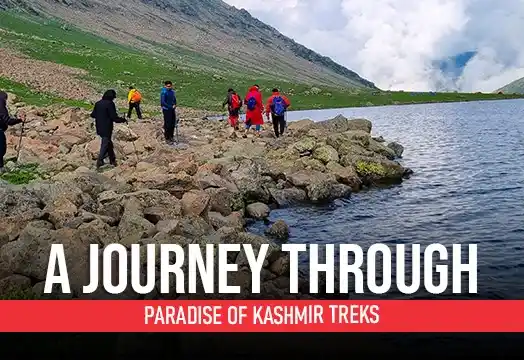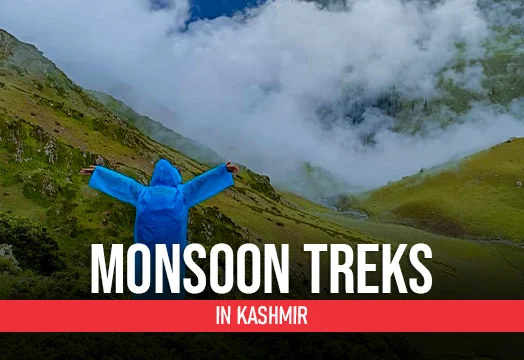Nafran Valley Trek

Region
Kashmir | India

Duration
7 Days

Max Altitude
13800 Ft.

Trekking Km
56 KM

Grade
Moderate to Difficult
Get in Touch with Our Trek Expert
91 7302321133 info@trekthehimalayas.comMonday - Saturday: 10 AM to 09.30 PM (GMT +5:30)
Sunday: 10 AM to 05.30 PM (GMT +5:30)
17000 /Person
- July-2026
- August-2026
- 5% GST will be applicable on Trek Cost and Add-ons
- Services from Aru to Mondlan.
- Meeting Point( Pickup/ Drop Point ): Tourist Reception Center, Rajbag, Srinagar.
- Reporting Time: 12:00 pm
- Drop Time:6:30 pm to 7:30 pm (Timings are subject to change based on weather and road conditions).
- Please reach Srinagar a day before to avoid any delays.
Add-ons
Insurance 280
- Insurance is mandatory.
- It is available for Indian citizens only.
- Non-Indians have to take insurance on their own.
- If you already have the high altitude trekking insurance, email for a refund after booking.
- The cancellation policy will be implemented in accordance with the trek cancellation policy.
- For more details about insuranceclick here
- + 5% GST will be applicable
Transport 1600
- Transportation from Srinagar to Aru and return is optional.
- Choose add-ons during booking. If missed, log in and add them later.
- Book transportation at least 10 days before the trek.
- Cancellation 4 or more days before the start of the trip results in a 100% cash refund.
- Cancellation less than 4 days from the start of the trip results in a 50% cash refund.
- Cancellations made on the trip date are not eligible for a refund.
- + 5% GST will be applicable
Offload 5000
- Backpack offload is optional.
- Choose add-ons during booking. If missed, log in and add them later.
- Book off-load at least 10 days before the trek.
- For offline bookings at the base camp, a convenience fee of Rs. 5500 applies.
- Cancellations made before the trip date will receive a full refund.
- + 5% GST will be applicable
Get in Touch with Our Trek Expert
91 7302321133info@trekthehimalayas.com
Monday - Saturday: 10 AM to 06 PM (GMT +5:30)
Important Advisory Note for Jammu and Kashmir Trekkers
Jammu and Kashmir stands at the forefront of the most beautiful states of India. Its charm is so overpowering that its landscapes seem an enhanced version of its counterparts in other states.
However, the state is linked to uncertainty because of security issues and political compulsions. So in effect to government decisions, we don’t always receive permits for our Kashmir treks. Or sometimes the government has to call off the civilian movements due to potential uncertainty, and we have to abide by the decision.
In case any such emergency arises, we have clearly laid down policy regarding this development:
- If the government issues a “no permission” advisory by April 30, 2026, we will refund your full trek fee. However, if the treks are running as per schedule after this date, the usual trek cancellation policy will be applied.
- Make sure to choose refundable flight options. It will greatly help you reschedule or cancel your travel without incurring any financial loss. Also, to be on a safer side, book your tickets after April, once you are better informed about the state of affairs in J&K.
- For trekkers from Southern, Western, and Eastern regions of India, it is well-advised to book a flight to Delhi. Here you will get more options if you want to opt for other Himalayan destinations, just in case. It is always better to keep 2 to 3 buffer days in your travel schedule.
Overview
Trek Name: Nafran Valley Trek
Days: 7
Adventure Type: Trekking
Base Camp: Aru
Season:Monsoon |
Month:July | August |
Country: India
Altitude: 13800 Ft.
Grade: Moderate to Difficult
Rail Head: Jammu
Stay: Camping (Twin sharing) & Hotel/Guesthouse (Separate for male & Female)
Food: Meals while on trek & at Hotel/Guesthouse (Veg & Eggs)
Location: Kashmir
Distance: 56 Km.
Trail Type: One way trail | Camping in various locations, starting and ending at the different point.
AirPort: Srinagar (sheikh ul-alam international)
Highlights:
- 5% GST will be applicable on Trek Cost and Add-ons
- Services from Aru to Mondlan.
- Meeting Point( Pickup/ Drop Point ): Tourist Reception Center, Rajbag, Srinagar.
- Reporting Time: 12:00 pm
- Drop Time:6:30 pm to 7:30 pm (Timings are subject to change based on weather and road conditions).
- Please reach Srinagar a day before to avoid any delays.
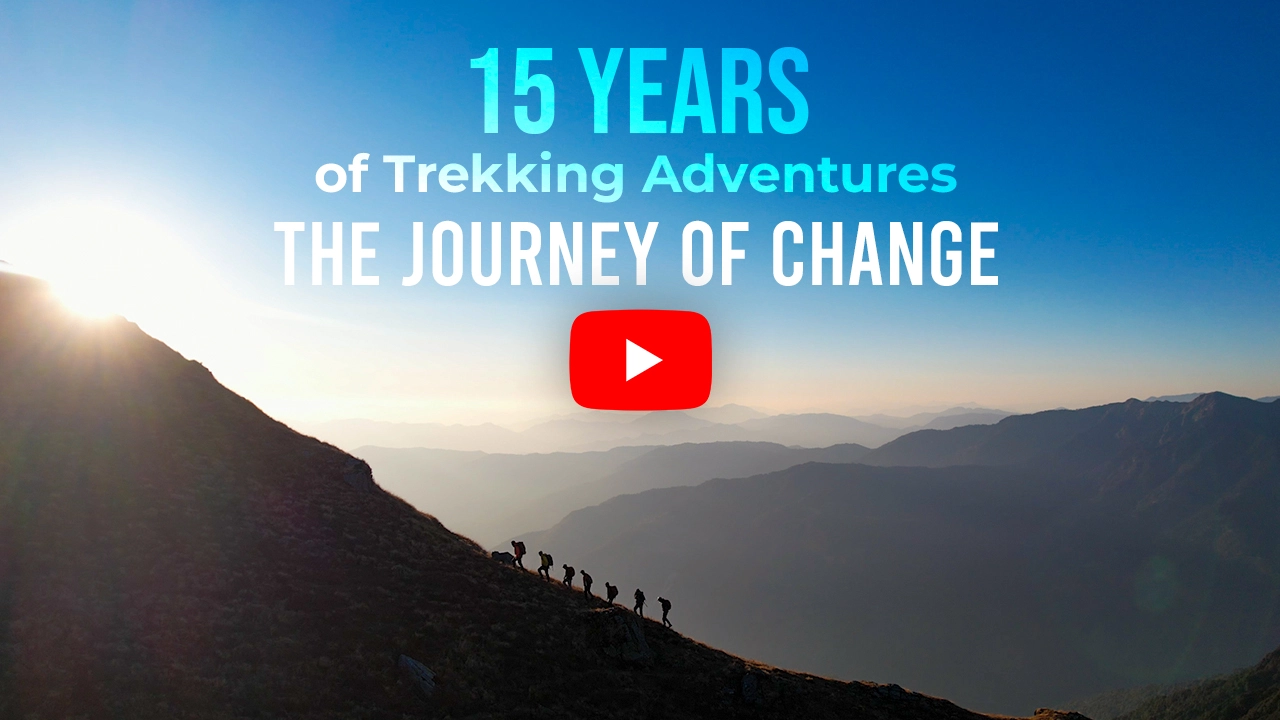
Why Nafran Valley Is A Must-Do Trek?
The beauty of Kashmir is simply bewitching and treks like Kashmir Great Lakes Trek and Tarsar Marsar Trek stand as great examples. While these two treks are immensely popular, there are many other trekking trails in Kashmir that are equally as beautiful and unfold in front of you the pristine and untouched beauty of Kashmir Valley. Nafran Valley is one such trek.
The trek to Nafran Valley starts from Aru village which is about 112 km away from Srinagar. Throughout the Nafran Valley Trek, you will cross varied sceneries from green meadows, and mystical jungles to an alpine lake - a complete bouquet for a trekking enthusiast. Aru Valley, Harnag Lake, and Nafran Valley altogether make this trek an interesting destination for trekking in Kashmir.
The meadows of Nafran Valley are inhabited by shepherds between June to October and stay in mud houses. During these months you will see a lot of cattle and horses grazing in the Nafran valley and in winter these shepherds descend down to lower altitudes when the Nafran Valley isn’t habitable anymore.
If you are planning an offbeat adventure in Kashmir then the Nafran Valley Trek is an amazing choice. This is a high-altitude trek so there are chances of AMS.
.webp)
Who Can Participate
- Age Requirement:
- Minimum 14 years
- First-timers are welcome, though prior trekking experience is preferred. Good fitness is a must.
- Fitness Criteria:
- If the trekker wants to carry a backpack then he/she should be able to carry a 10-12 kg backpack. If opt Off-load option then the trekker should be able to carry 3-5 kg backpack.
- If a trekker's BMI is more or less than the normal range (18-27), please consult our Trek Coordinator before booking.
Nafran Valley Trek Itinerary
Drive From Srinagar To Aru
- Altitude: 2,400 m/ 7,950 ft.
- Drive Distance: 112 km | 4 hrs.
- Stay in Home Stay.
The trek starts from Aru village. We will begin our journey from Srinagar and drive about 112 km from Srinagar to reach Aru. Arrive at the designated pick-up point and our representatives will pick you up and drive you to Aru. From Srinagar, we will drive to Pahalgam which is 100 km away from Srinagar and Aru village lies 12 km away from Srinagar across the Lidder River.
Aru is a fairly developed tourist spot, located on the bank of the Lidder River and is also the base camp for the popular Tarsar Marsar Trek and the Kolahoi Glacier Trek. It is also a hub for adventure activities like horse riding and heliskiing in winter. Trout fishing in the Lidder River is also a popular sport here. Network connections are not very stable in Aru and all network connections don’t work there so you need to have all your communications wrapped up at Pahalgam. We will be staying in camps at Aru and our campsite is located in a beautiful location by the Lidder River.
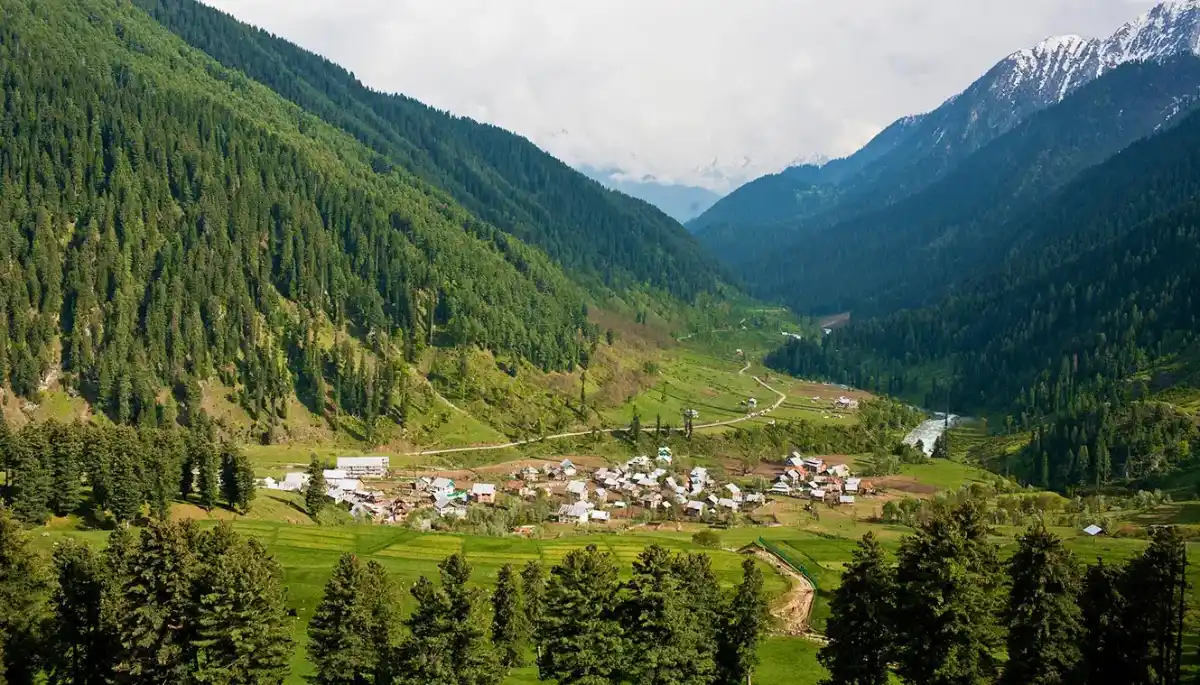
Trek From Aru To Araam Pathri
- Altitude(Araam Pathri): 2,950 m/ 9700 ft.
- Trek Distance: 12 km | 5-6 hrs approx.
- Stay: In camps (twin sharing).
This is our first day of trekking in Kashmir and today we will trek from Aru to Arram Pathri. The trek starts with a gentle uphill climb and after walking for about 800 meters, you will enter a forested zone. Continue walking and after some time the trek forks into two. The left trail leads to a clearing with a vantage point. It takes about 3 hrs to reach. The right path, on the other hand, leads us to our campsite.
Follow the trail on the right which will lead you to a muddy patch. There’s also a higher road that can be taken during the rainy days when there is too much mud but it is not accessible most of the time. Once you reach the muddy patch, it’s a steep uphill climb of about 500 meters at the end of which you will reach a shepherd settlement called Geerwad. From here on, you will walk on grasslands and forest covers all the way to a small riverside clearing. This is Gagad Pathri. Araam Pathri is yet a little ahead. On the way to Araam Pathri you will find an abandoned hermit’s cave and even remains of an ancient fort. Walk a little further and you will cross an wooden plank bridge to get on the right side of the river followed by another crossing that will again take you to the left side of the river. Here, you will observe a couple of mud huts that serve as the summer dwellings of the shepherds. This clearing is called Kansal Pathri. Keep walking uphill along the ridge on your left towards Aaram Pathri. Once you reach a section with a cluster of Gujjar huts, you know you have reached Aram Pathari. Upon reaching Araam Pathri, we will find a suitable location to pitch the camps.
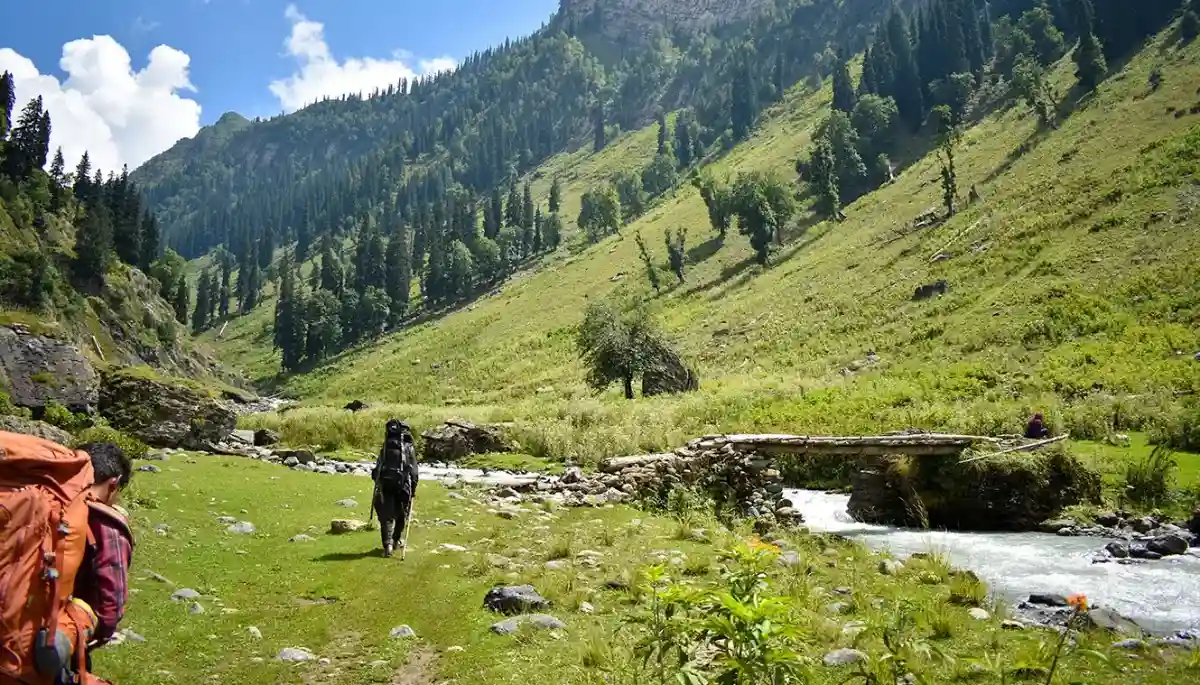
Trek From Araam Pathri To Harnag Lake via Harnag Pass
- Altitude(Harnag Lake): 3,650 m/ 12100 ft.
- Altitude(Harnag Pass): 3800m/12500 ft.
- Trek Distance: 10 km | 6-7 hrs.
- Stay: In tents (twin-sharing).
Today we will trek from Araam Pathri to Harnag Lake via Harnag Pass. The climb up the pass is steep and also has some rocks and boulders along the way. Be very careful in the rocky section as some buolders are quite slippery due to a stream flowing from the top of the pass. As you reach the Harnag Pass, from the top you can see the wide Nafran Valley below and you will also spot the Harnag Lake. The descent to Harnag Lake has a similar terrain as during the ascent. Once you reach the Harnag Lake, sit for a while and enjoy the serenity. Tonight we will camp by this beautiful lake.
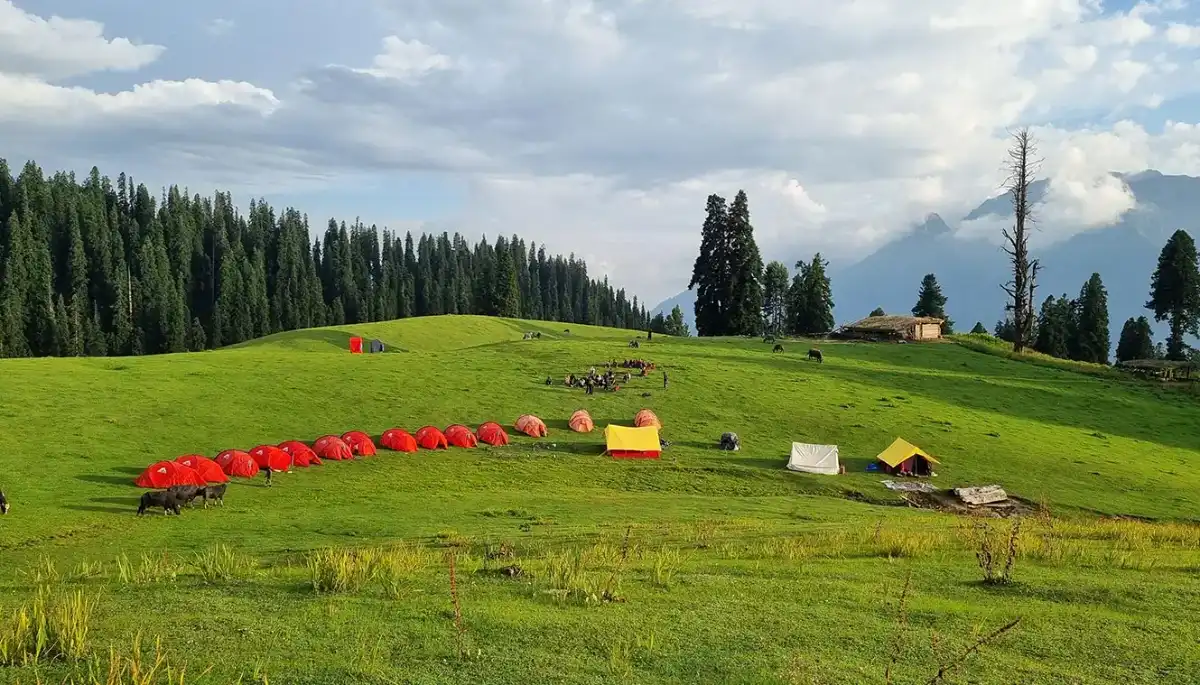
Trek From Harnag Lake to Harbhagwan Lake and back to Harnag Lake
- Altitude(Harbhagwan Lake): 4200 m/13800 ft.
- Trek Distance: 8 km(Both way) | 5-6 hrs.
- Stay: In tents (twin-sharing).
Today’s hike is going to be challenging. You’ll start on a clear trail in a wide valley, which gradually becomes more hilly. After crossing two streams about 2 km from Harnag Lake, you’ll arrive at the Kolahoi glacier viewpoint. Here, you’ll get an amazing view of the massive Kolahoi glacier at the edge of Mt. Kolahoi on your left. Take a moment to enjoy the sight of the glacier in the valley—it’s not something you see every day! You’ll also notice the east face of Mt. Kolahoi.
Look to the right of the glacier to spot a pointed peak. This is the gateway to Harbhagwan Lake. The trail gets steeper here, with a tough 2 km climb ahead. You’ll gain about 2,264 feet in altitude during this stretch, so take it slow and watch for signs of high altitude sickness. If you experience any symptoms, descend immediately.
The ascent begins on soft, grassy terrain with many boulder sections. Be careful on the boulders, as they can cause slips, falls, and ankle twists. Once you reach a flatter area on the ridge, the trail fades away. Follow the stream flowing from the top—it will lead you straight to Harbhagwan Lake. Harbhagwan Lake is incredibly beautiful, set in a stunning location. Big chunks of ice break off the hanging glacier and feed the pristine blue lake. After spending some time by the Harbhagwan Lake, we will descend back to Harnag Lake.
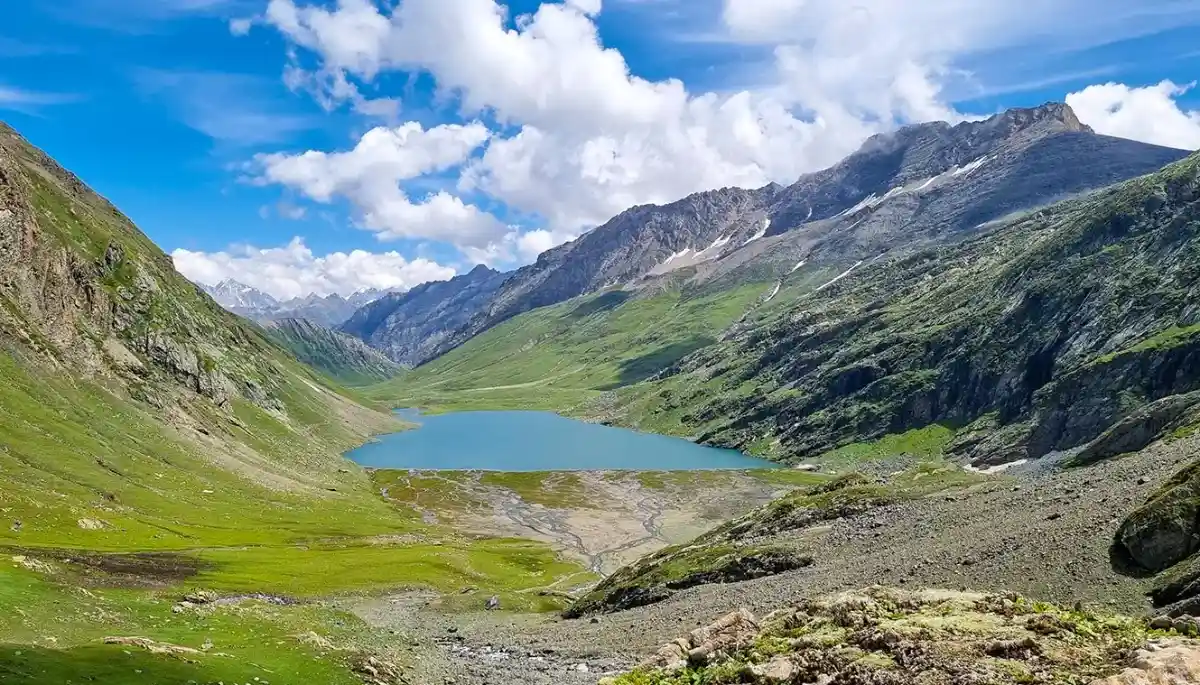
Trek From Harnag Lake to Dhingapani (Nafran Valley)
- Altitude(Nafran Valley): 3,200 m/10,500 ft
- Trek Distance: 8 km | 4-5 hrs approx.
- Stay: In tents (twin-sharing).
Today is the day you have been waiting for. We will finally arrive at the beautiful Nafran Valley. From Harnag Lake, we will descend down to the beautiful Nafran Valley. From Harnag Lake it's a 9 km descent to Nafran Valley. Be extra careful on your descent as it's through rock and boulders and can be quite tricky. Listen to your Trek Leaders advice carefully. Enjoy your walk along the beautiful meadows and occasionally stop by to capture the beauty of nature all around. The magnificent meadows of Nafran Valley with the rock formations and a creek running through the valley will completely capture your senses. We will spend the night in this beautiful Valley.
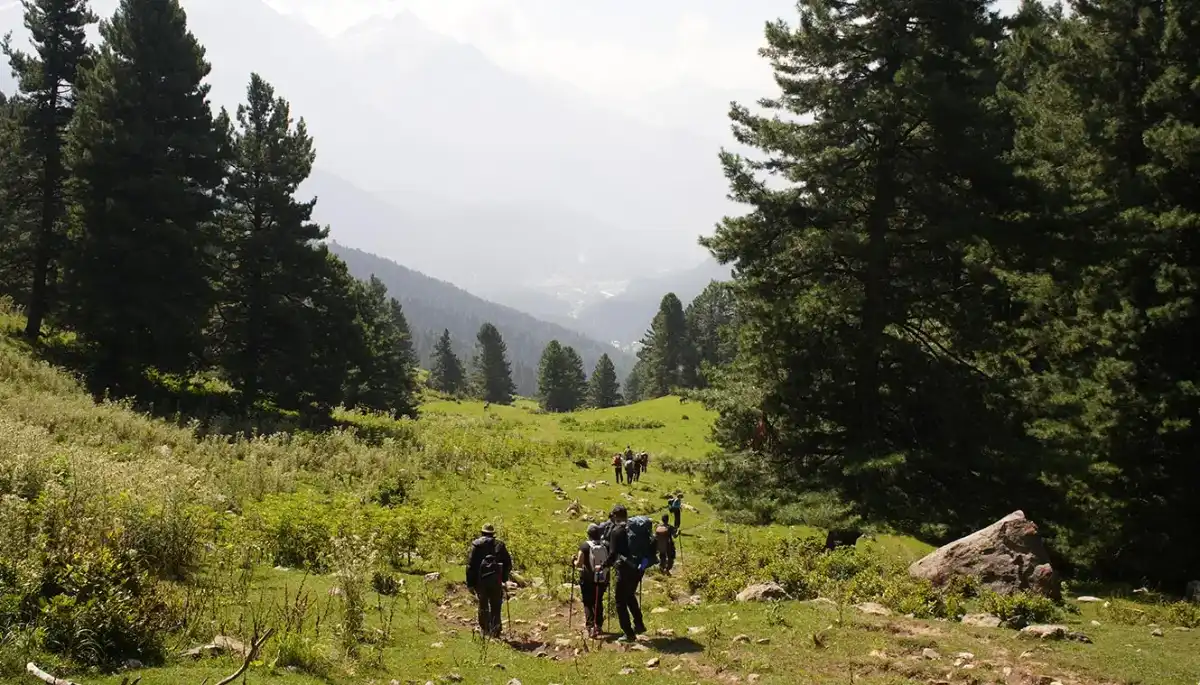
Trek From Dhingapani(Nafran Valley) To Bhaj Margi via Bhajmargi Pass
- Altitude(Bhajmargi): 2900 m/9,500ft.
- Trek Distance: 10 km | 7-8 hrs.
- Stay: In tents (twin sharing).
Today we will descend to Bhaj Margi, one of the most beautiful campsites on the Nafran Valley Trek. From Nafran Valley, walk down the ridge while enjoying magnificent views of the meadows and mountains around. You will cross a forested zone before arriving at the clearing of Bhaj Margi. This is our camping spot for the night. At Bhaj Margi, you will spot horses and cattle grazing leisurely, a beautiful sight to witness.
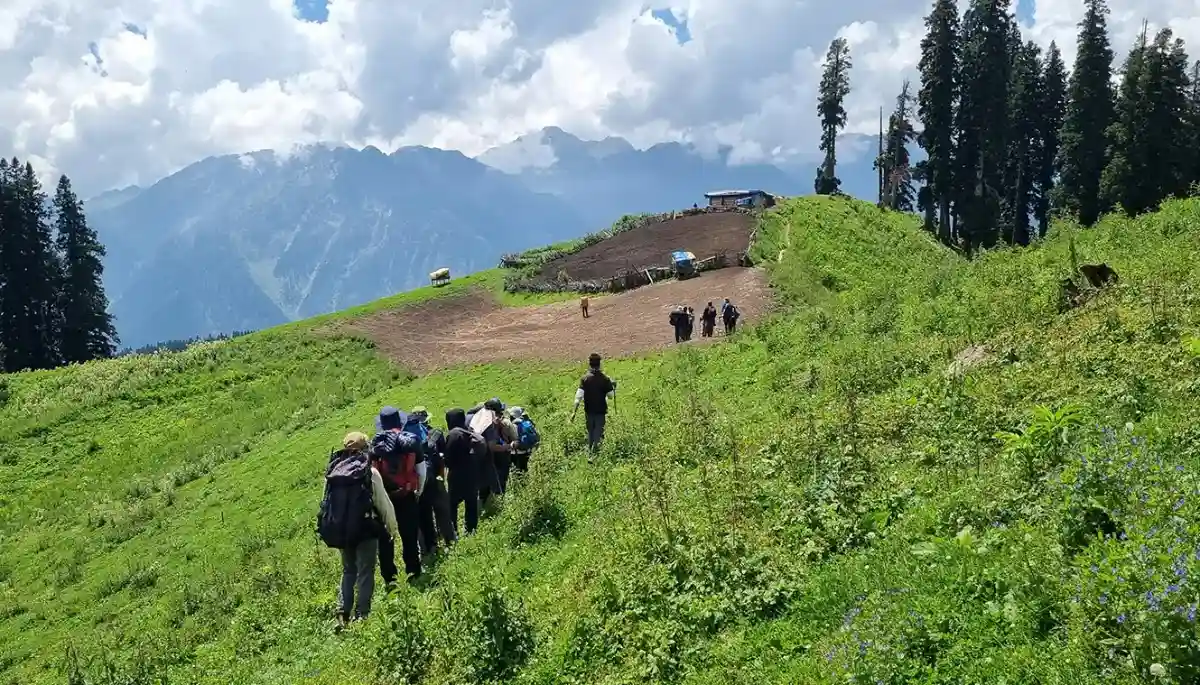
Trek From Bhaj Margi To Mondlan And Drive Back To Srinagar
- Trek Distance(Bhaj Margi to Mondlan): 8 km | 3-4 hrs.
- Drive Distance(Mondlan to Srinagar): 104 km | 4 hrs.
- An easy and gentle walk down to the valley.
- Expect to reach Srinagar by 6:00 PM.
This is the last day of trekking in the mountain and also the last day of this beautiful journey. Today we will trek back from Bhaj Margi to Mondlan and drive back to Srinagar. From the campsite, the trail keeps going southwest until you reach a large wooden gate, which marks the end of the trail. You will now follow a muddy path through a forest cover down to a small shepherd settlement called Shul Margi.
From Shul Margi, you will have to cross a small stream to move further downwards and then again you will have to cross a bigger stream and enter into a forested zone. The forest runs parallel to the road that leads you to Aru. But we will continue on this forested trail and it will lead us into a big clearing that offers a stunning view of Pahalgam.
From here, it is a short descent to Mondlan village situated beside a small mountain stream. Mondlan is 8 km away from Aru and it takes a drive of about 20 minutes to reach Aru. You can expect to reach Srinagar by 6:00 PM.
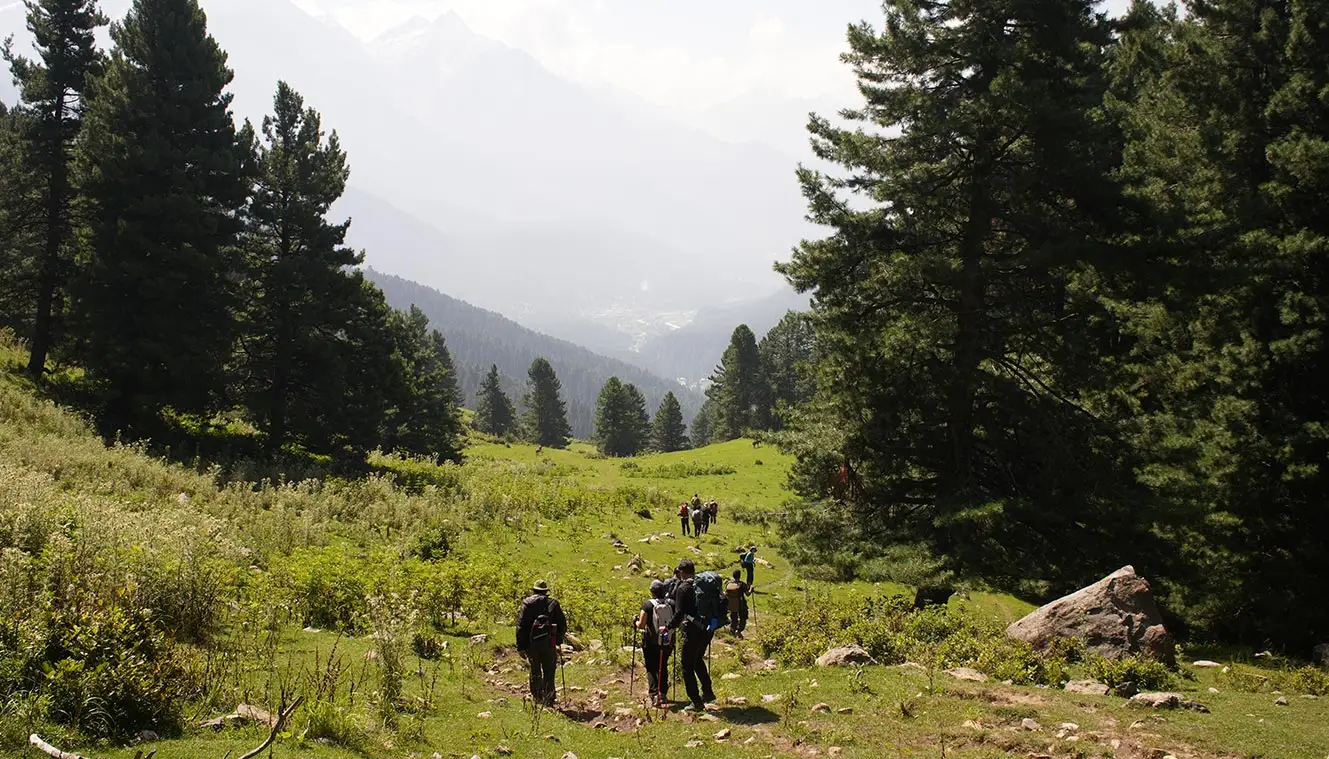
Day-1: Drive From Srinagar To Aru
- Altitude: 2,400 m/ 7,950 ft.
- Drive Distance: 112 km | 4 hrs.
Day-2: Trek From Aru To Araam Pathri
- Altitude(Araam Pathri): 2,950 m/ 9700 ft.
- Trek Distance: 12 km | 5-6 hrs.
Day-3: Trek From Araam Pathri To Harnag Lake via Harnag Pass
- Altitude(Harnag Lake): 3,650 m/ 12100 ft.
- Altitude(Harnag Pass): 3800m/12500 ft.
- Trek Distance: 10 km | 6-7 hrs.
Day-4: Trek From Harnag Lake to Harbhagwan Lake and back to Harnag Lake
- Altitude(Harbhagwan Lake): 4200 m/13800 ft.
- Trek Distance: 8 km(Both way) | 5-6 hrs.
Day-5: Trek From Harnag Lake to Dhingapani (Nafran Valley)
- Altitude(Nafran Valley): 3,200 m/10,500 ft
- Trek Distance: 8 km | 4-5 hrs approx.
Day-6: Trek From Dhingapani(Nafran Valley) To Bhaj Margi via Bhajmargi Pass
- Altitude(Bhajmargi): 2900 m/9,500ft.
- Trek Distance: 10 km | 7-8 hrs.
Day-7: Trek From Bhaj Margi To Mondlan And Drive Back To Srinagar
- Trek Distance(Bhaj Margi to Mondlan): 8 km | 3-4 hrs.
- Drive Distance(Mondlan to Srinagar): 104 km | 4 hrs.
Nafran Valley Trek Graph
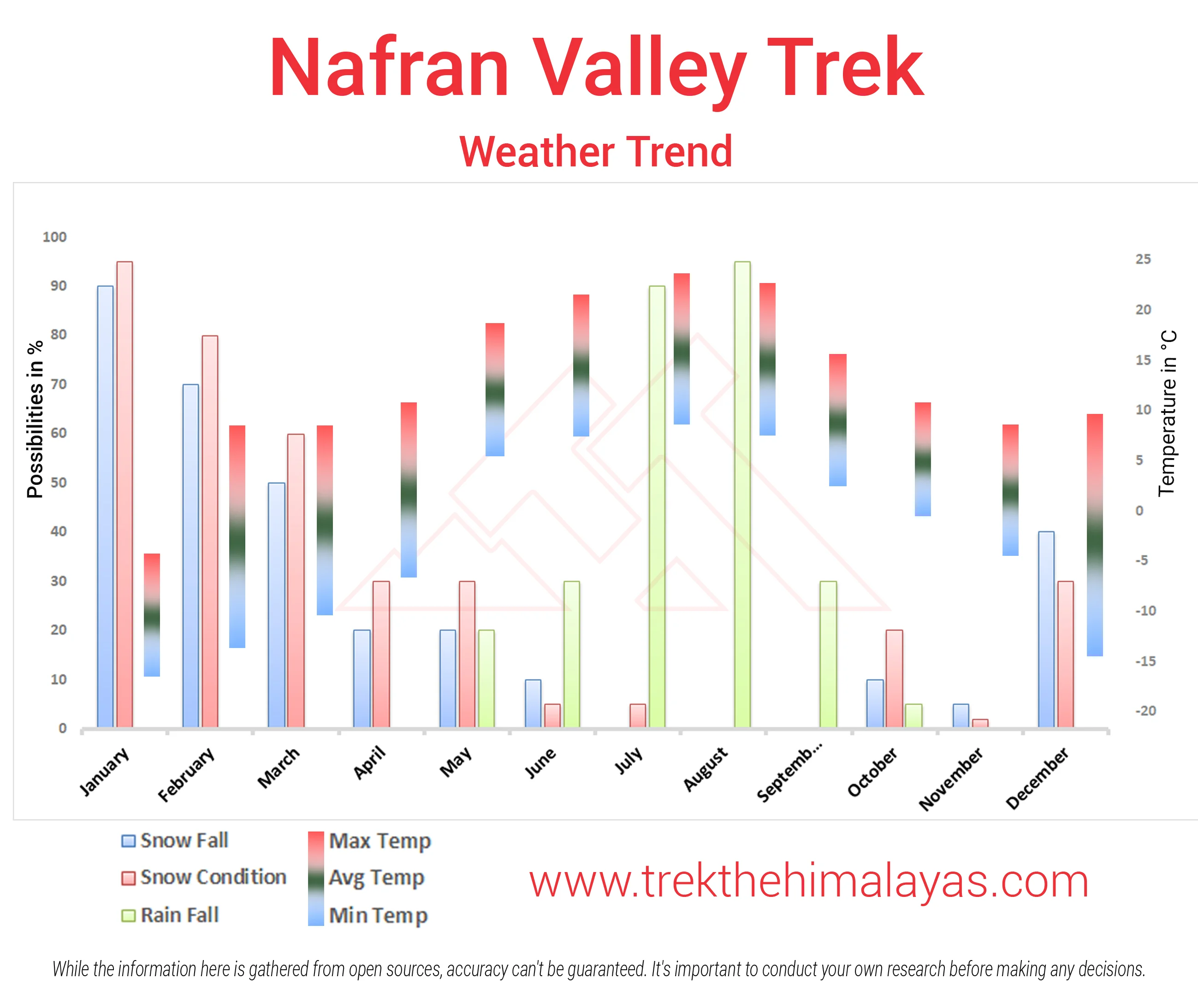
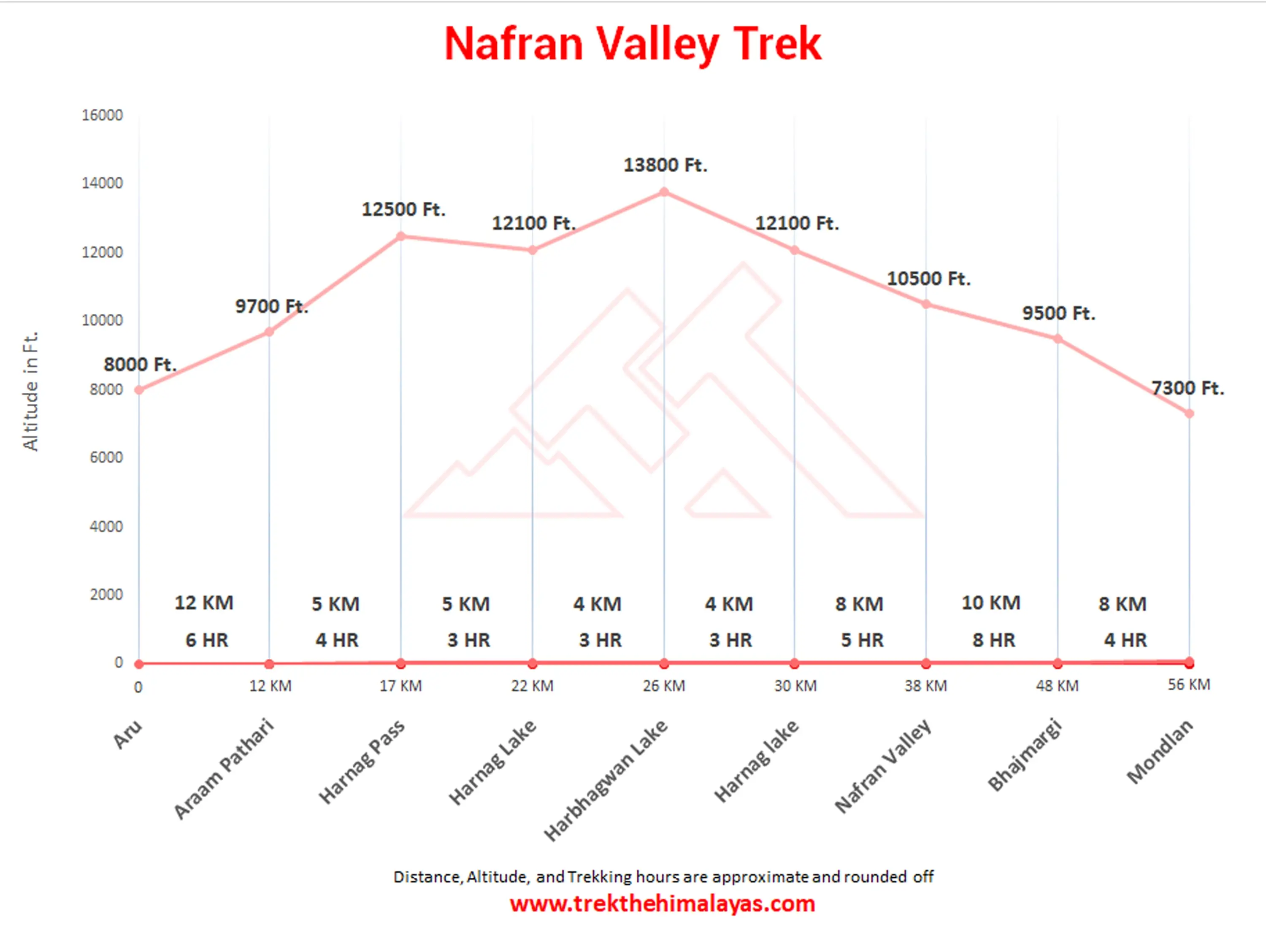
- Pulse rate at rest must be in between (60 to 100 beats per minute).
- Blood Pressure Reading must be in between (DIASTOLIC 75 – 85, SYSTOLIC 100 - 130 mm Hg).
- Respiratory rate at rest must be in between (12 to 20 breaths per minute).
- Should not have Liver and kidney issues.
- Should not have Diabetes Mellitus, Bronchial Asthma, Heart problems, Hypertension, etc.
- No pacemaker implant.
- People with Sinus issues, Epilepsy please contact to trek coordinator before booking the trek.
- If your BMI is not normal, Please contact our Trek coordinator before Trek booking.
Medical & Disclaimer Form (Mandatory Documents) Click here to download Medical & Disclaimer Form
Government employees can avail the benefit of Special Casual Leave (SCL) when they join us for a trekking expedition. As per Pay Commission guidelines, up to 30 days of Special Casual Leave can be availed in a calendar year for trekking or mountaineering expeditions conducted through a registered organisation.
Trek The Himalayas is a registered adventure tour operator with the Indian Mountaineering Foundation (IMF) and the Ministry of Tourism (MoT), making your trek eligible for SCL benefits.
To apply, email us at info@trekthehimalayas at least 20 days before the trek departure date, with the following details:
- Trek name and trek date
- Booking details
- Full name
- Designation
- Department and department address
This benefit is exclusive to Indian Government employees and is applicable only for treks within India.
- Junior trekkers (below 15 years) should have a company of parents/guardians.
- Trekkers between 15 to 18 years can come solo with the disclaimer form signed by parent/guardian.
- Medical & Disclaimer Form (Mandatory Documents) Click here to download Medical & Disclaimer Form
Important Links
- Mandatory Documents to Bring on A Trek Click Here.
- How to pay Add-ons, Submit Medical Forms, and Dietary Preferences Click Here to watch Video
How To Reach
Pick-Up Information
- Pick-up location: Tourist reception center, Raj Bagh, Srinagar.
- Once you have reached Srinagar, TTH will manage the rest of your travel arrangements, if you have opted for TTH's pick-up service, you can select this option during the booking process by adding it as an add-on.
- Do reach Srinagar one day before your trek date for a safer side.
- Pick-up Place & Time: Tourist reception center, Raj Bagh, Srinagar 12:00 noon.
Options to Reach Srinagar
1. If you are planning to fly to Srinagar which is well connected to all major airports in India, you can reach the Tourist reception center, Raj Bagh in appx 40 min via taxi from the airport (approx 13 Km).
2. If you’re coming by train, there are two railway stations.
- Jammu railway station is about 260 km away and takes around 8 hours by bus.
- Udhampur is 200 km away and from there, it is a 6-hour bus journey to Srinagar.
3. If you are taking a bus from Jammu, then you have multiple options to take. There are two gates outside Jammu ISBT. You will get shared cabs from both of these gates.
4. If you are reaching the Railway Station, the share cabs to Srinagar will cost between Rs 700 to Rs 1000.
5. Shared cabs are more from the Jammu ISBT compared to the Railway Station. You can travel from the Railway station to the bus stand. The fare of the bus will be Rs 10. The auto will charge around Rs 80 to 120.
Drop-Off Information
- The designated drop-off point is Nishat Garden near the parking area, Srinagar.
- Arrive in Srinagar by 6:00 pm.
- If you have to make any arrangements for further travel from Srinagar, do it the next day.
- TTH offers comfortable transportation through Tempo Traveler, Bolero, or equivalent vehicles. If you wish to upgrade your mode of transportation, please contact your trek coordinator for further assistance.
.webp)
.webp)
Cost Terms
Inclusion
1. Accommodation (as per the itinerary):
- Guest houses on Day 1 (twin/triple sharing basis).
- Camping during the trek (Day 2 to Day 6).
2.Meals (Veg + Egg):
- All meals while trekking.
- Day 1 Dinner to Day 7 Pack Lunch.
3. Support:
- 1 Versatile base camp manager handles communication and deploys extra manpower in emergencies.
- 1 Mountaineering & First aid qualified professional expedition Leader.
- 1 Experienced high-altitude chef.
- Local experienced guides (Number of guides depending on the group size).
- Enough support staff.
4. Trek equipment:
- Sleeping bag, Sleeping liners (if required), mattresses, and Utensils.
- 3 men all season trekker tent (twin sharing), Kitchen & Dining tent, Toilet tent.
- Camping stool, Walkie talkie.
- Ropes, Helmet, Ice axe, Harness(if required).
- Climbing Boots, Gaiters & Crampon /micro spike (if required).
5. First aid:
- Medical kit, Stretcher, Oxygen cylinder, Blood pressure monitor, Oximeter, Stethoscope.
7. Cloakroom service at base camp.
8. Mules/porters to carry the central luggage.
9. All necessary permits and entry fees, up to the amount charged for Indians.
10. Services from Aru to Mondlan.
11. Trek Completion Certificate.
Exclusion
- Insurance (For non-Indian Nationals, NRI or OCI card holders).
- Food during the transit.
- Any kind of personal expenses.
- Mule or porter to carry personal luggage.
- Emergency evacuation, hospitalization charge, etc.
- Any extra costs incurred due to extension/change of the itinerary due to natural calamities roadblocks, vehicle breakdown, etc. factors beyond our control
- Transportation (as per the itinerary):
- Day 1
- Mondlan to Srinagar (Day 7).
- Srinagar Accommodation: The stay at Srinagar on the last day is not included in the trek fee. However we can assist you in booking a hotel or a houseboat for the same, please let us know at least 15 days in advance to the start of the trek. The intimation is by email only at info@trekthehimalayas.com
- Support
- Anything not specifically mentioned under the head Inclusion.
Things can be provided on demand and availability (participant has to pay extra for these things).
1- Satellite phone/set phone - A type of mobile phone that connects via radio links via satellites orbiting the Earth instead of terrestrial cell sites like cellphones. Therefore, they can operate in most geographic locations on the Earth's surface.
Note: Satellite phones are prohibited in Leh-Ladakh, Kashmir, Sikkim due to security concerns related to its proximity to sensitive international borders. Only authorized personnel, like government officials and military, can use them with special permission from the Department of Telecommunications (DoT).
2- Gamow/PAC HAPO Bag (Portable Hyperbaric Bag) - It is a unique, portable hyperbaric chamber for the treatment of acute mountain sickness (AMS), also known as altitude sickness.
3- AEDs (Automated External Defibrillators) - Are portable life-saving devices designed to treat people experiencing sudden cardiac arrest, a medical condition in which the heart stops beating suddenly and unexpectedly.
Cancellation Terms
To request a cancellation, please email us at info@trekthehimalayas.com using your registered email ID.
Cancellations prior to 25 days from the start of the Trip
Refund Options
- 5% deduction of trek fee
- 100% trek fee cash voucher for any trip till one year
- Transfer your trek (any trek, any date) to your friend
Cancellation between 24 days and 15 days to the start of the Trip
Refund Options
- 30% deduction of trek fee
- 100% trek fee cash voucher for same trip till one year
- 85% trek fee cash voucher for any trip till one year
- Transfer your trek (same trek, any date) to your friend
Cancellation between 14 days and 10 days to the start of the Trip
Refund Options
- 50% deduction of trek fee
- 80% trek fee cash voucher for same trip till one year
- 70% trek fee cash voucher for any trip till one year
- Book the same trek, in the same season, with any other batch
- Transfer your trek (same trek, any date) to your friend
Cancellation less than 9 days to the start of the trek.
Refund Options
- No cash refund
- 20% trek fee cash voucher for the same trip till one year
- 10% trek fee cash voucher for any trip till one year
- Transfer your trek (same trek, same date) to your friend
- To reschedule a trek (same trek only), a 30 % rescheduling fee of the trek cost will apply.
Cancellation Policy (Emergency Cases):
In case of a death in the immediate family (parents, siblings, spouse, children) or if the trekker is hospitalized (min. 48 hours) or suffers a fracture (leg/arm) within a week before the trek, even if canceled a day before:
90% trek fee refund in cash & 10% as a voucher (valid for 1 year, for any India trek).
Valid documents required. We’re here to support you during tough times.
Note:
- Change of trek batch is dependent on the availability of seats in the batch
- In case of transferring a trek to a friend, he/she should satisfy all the mandatory requirements put forward by TTH
- TTH holds the right to change/cancel the policies, without prior notice
Booking and Payments
- The Participant is responsible for verifying the accuracy of all details, including Trip dates and personal documentation, at the time of booking.
- Payments must be made in accordance with the timelines and instructions provided by TTH. Late payments may result in cancellation of booking without refund.
- In the event of a cash refund, only the portion of the payment made in cash shall be eligible for refund in cash. Any booking made using voucher, discounts, promotional codes, or through any non-cash mode of payment shall not be eligible for a cash refund under any circumstances.
- Refunds, if applicable, shall be processed within 15–30 working days of confirmation.
- All add-on bookings are subject to the respective add-on cancellation policy, and refunds will be processed accordingly.
- Voucher Terms
- This is a non-transferable voucher
- The voucher cannot be merged with any other offer of Trek The Himalayas
- The voucher is valid for Trek booked directly with Trek The Himalayas in India
- To avail the voucher please use your register phone number or e-mail id
- All the other Terms of booking a trek with Trek The Himalayas are applicable to the voucher
Itinerary and Modifications
- TTH reserves the right to modify, shorten, or cancel any part of the Trip due to transportation delays, weather, health emergencies, or other unforeseen circumstances including Force Majeure.
Cancellations and Refunds
- No refunds or vouchers, partial or otherwise, shall be provided for voluntary withdrawal, non-utilisation of services, or removal from the Trip.
- If TTH cancels the Trip before arrival at the designated pick-up point due to unforeseen circumstances or Force Majeure, the Participant may choose from:
- An alternate Trip/date.
- A credit voucher valid for one (1) year.
- Transfer to another Trip, with cost differences payable by the Participant.
- If the Trip is abandoned post-arrival at the designated pick-up point, no cash refund or voucher shall be issued. The Trek Again Policy may apply at TTH’s discretion.
- TTH shall not be liable for any associated travel costs such as flights, accommodation, or visa fees.
Force Majeure
- Events beyond its control including but not limited to earthquakes, landslides, strikes, curfews, war, pandemic, government restrictions, heavy rainfall or snowfall, windstorms, road blockages, trail disruption, or withdrawal of permits, TTH shall not be held liable for any cancellation, delay, or service modification caused by Force Majeure.
Trek Essentials
Rent EquipmentPDF Of Trek Essential Download
| Backpack with rain cover | (50 - 60 ltr) with comfortable shoulder straps |
| Day pack with rain cover | 20 - 30 ltr (If off-load opted) |
| Walking stick | Advisable (At least one) |
| Water Bottle / Hydration pack | 2 bottles of one liter each, People who use hydration pack 1 hydration pack and 1 bottle of one liter. |
| Small size tiffin/lunch box | 1 Nos |
| Snacks | Energy bars, dry fruits, electral/ors |
| Personal Medical Kit | Consult your doctor |
| T-Shirt (Synthetic quick dry) | 2 Full & 2 Half sleeves |
| Fleece T-shirt | 1 Nos |
| Fleece jacket | 1 Nos |
| Windproof Jacket | 1 Nos |
| Down feather / Hollow jacket | 1 Nos |
| Thermal inner (Upper and Lower) | 1 Pair |
| Trek Pant (Synthetic quick dry) | 3 Nos |
| Fleece Pant | Not required |
| Waterproof gloves | Not required |
| Fleece / woollen gloves | 1 Pair |
| Poncho / waterproof Jacket and pant | 1 Nos |
| Sunscreen | 1 Nos |
| Moisturiser | 1 Nos |
| Chap-stick / Lip balm | 1 Nos |
| Toothbrush and toothpaste | 1 Nos |
| Toilet paper & Wipes | 1 Nos |
| Soap / hand sanitizers | 1 Nos |
| Antibacterial powder | 1 Nos |
| Quick dry towel | 1 Nos |
| Head torch | 1 Nos. (Avoid Hand torch) |
| Sun Cap | Not required |
| Woolen cap | 1 Nos. |
| Balaclava | Not required |
| Buff / Neck-gaiters | 2 Synthetic |
| Sunglasses | UV with dark side cover, People who wear spectacles - (A)- Use contact lenses | (B)- Photo chromatic glasses |
| Trekking shoes | 1 Pair (Water-resistant, high ankle, good grip) |
| Floaters / flip-flops | 1 Pair |
| Cotton socks | 7 pairs |
| Woollen socks | 1 pairs |
| Gaiters | 1 Pair (TTH provides when required) |
| Micro spikes | 1 Pair (TTH provides when required) |
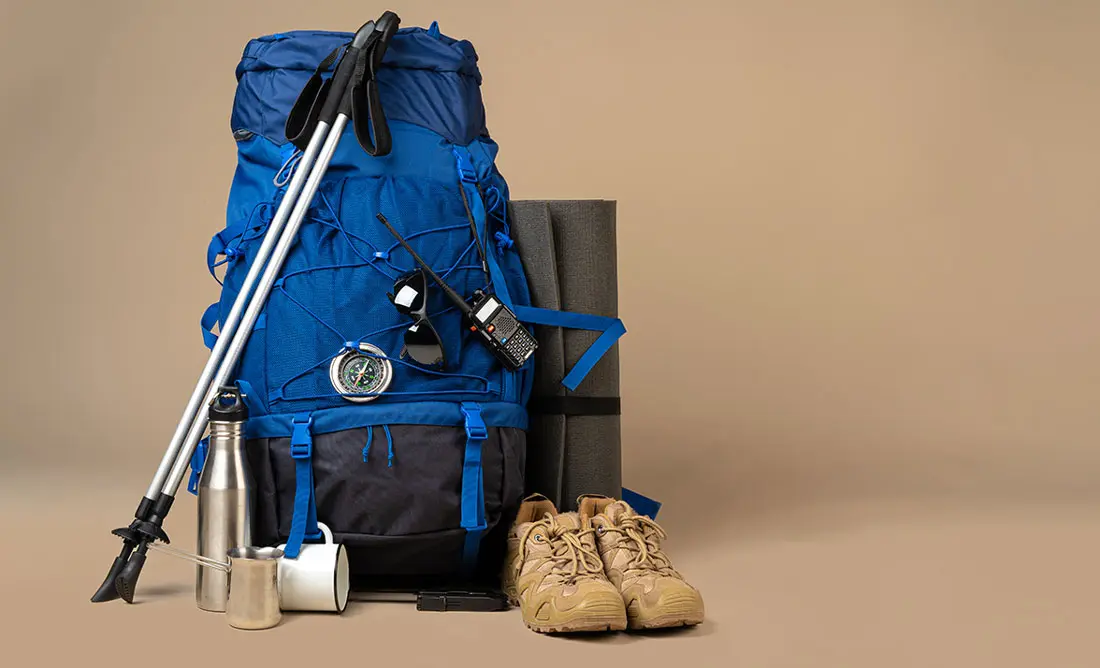
Frequently Asked Questions(FAQ)
To register with TTH, visit our website - www.trekthehimalayas.com and create your account. To create your account you will need to use your email address and fill in all the details, set your unique password and your account is ready to use.
- To book a trek with TTH, you first need to register with us and create an account.
- Choose the trek that you want to do and click on available dates.
- You will land at the login page, fill in the required details.
- Add Participants, choose add-on services click on the Pay now button, choose your preferred payment method, and make the payment. TTH accepts multiple payment options, including credit/debit cards, net banking, and UPI.
- You will receive a confirmation email from TTH with all the necessary details about the trek, including the meeting point, transportation, accommodation, and other important instructions.
- Click Here to watch Video
please send an email to us at info@trekthehimalayas.com or reach out to the numbers provided in the Help and Support section of your Trek Page. We will ensure that your issue is promptly resolved.
To book services such as off-load luggage and transportation, you can find them listed as add-ons. These additional services can be booked at the time of your initial booking. If you miss booking add-ons during the initial reservation, you can log in anytime and easily book 4 days before the departure date add-ons through the platform.
If you have booked the wrong trek or selected the wrong date, don’t worry! You can contact us at +91 9368882322 (Monday to Saturday, 10 AM to 10 PM) or email us at info@trekthehimalayas.com. You can also discuss this with your trek coordinator. Please make sure to inform us at least 10 days before the departure of your trek. Only then can we help you reschedule or arrange another trek for you.
We recommend visiting our "Suggest Me a Trek" page. By filling out the form, our experts will contact you with the best possible trek options based on your preferences and experience level. Alternatively, you can reach out to us via email at info@trekthehimalayas.com or give us a call using the numbers provided on our website for personalized assistance and recommendations.
Family treks differ from regular treks by focusing on ease of difficulty, offering shorter durations for younger participants, Kid-friendly and easily digestible foods, child-friendly activities, maintaining a higher guide ratio for diverse age groups, and implementing additional safety measures for families.
Family Trek with Kids recommendation Only Dayara Bugyal and Chopta Chandrashila Trek.
Minimum age for TTH treks is typically 7 years, though this may vary depending on the specific trek.
Yes, you can take a kids to a high-altitude trek with a parent. Discuss with a trek expert before booking a trek.
- Junior trekkers (below 15 years) should have a company of parents/guardians.
- Trekkers between 15 to 18 years can come solo with the disclaimer form signed by parent/guardian.
- Medical & Disclaimer Form (Mandatory Documents) Click here to download medical and disclaimer form
Physical Fitness: Ensure your child is physically fit. Engage them in regular exercise, outdoor activities, and hikes to build stamina and endurance. Hydration: Emphasize the importance of staying hydrated at high altitudes. Encourage your child to drink water regularly, even if they don't feel thirsty. Proper Nutrition: Provide a well-balanced diet with sufficient carbohydrates for energy and foods rich in iron to prevent altitude sickness. Adequate Sleep: Ensure your child gets enough sleep in the days leading up to the trek. Quality rest is crucial for altitude adaptation. Educate on Altitude Sickness: Teach your child about the symptoms of altitude sickness, such as headache, nausea, and dizziness. Encourage them to communicate any discomfort immediately. Appropriate Clothing and Gear: Dress your child in layers to adjust to changing temperatures. Ensure they have appropriate trekking gear, including sturdy footwear. Positive Mindset: Foster a positive mindset. Encourage your child, and let them know it's okay to take breaks when needed. Medical Check-Up: Schedule a medical check-up before the trek to ensure your child is fit for high-altitude activities. Consult with a healthcare professional about any potential health concerns.
TTH takes special care to provide wholesome and nutritious food for children on treks. Here are some of the foods that are typically served for children:
Breakfast: For breakfast, TTH serves a variety of options like porridge, cornflakes, bread, butter, jam, honey, boiled eggs, omelettes, and pancakes. Children can choose from these options to fuel themselves for the day's trek.
Lunch: For lunch, TTH serves lunch which includes rotis, vegetables, rice, dal, and salad. The rotis are usually made fresh on the trek and are a good source of carbohydrates. The dal and vegetables provide protein and other essential nutrients.
Snacks: TTH provides healthy snacks like fresh fruits, dry fruits, energy bars, cookies, and biscuits to keep the children energized throughout the day.
Dinner: For dinner, TTH serves a hot and wholesome meal which includes soup, rice, dal, vegetables, and a non-vegetarian dish (if requested in advance). Children can also choose from a variety of desserts like custard, jelly, and fruit salad.
Dietary requirements: If a child has any special dietary requirements, TTH can cater to those needs as well. For example, if a child is lactose intolerant or allergic to nuts, the kitchen staff can make arrangements to accommodate those requirements.
Choosing the right trek for a beginner can be a bit overwhelming as there are many factors to consider such as distance, elevation gain, terrain difficulty, weather, and time of year. Here are some tips that can help you choose the right trek for a beginner:
1. Determine fitness level: Assess the fitness level of the beginner to understand their physical capabilities. This will help you select a trek that is challenging but not too difficult.
2. Choose a well-traveled trail: A well-traveled trail will have more amenities such as signposts, water stations, and shelter. It is also safer as there will be other hikers on the trail.
3. Consider the length of the trek: For beginners, it is recommended to start with a shorter trek that can be completed in a day or two. This will help them get acclimatized to trekking and build their confidence.
4. Look for gradual elevation gain: Choose a trek with a gradual elevation gain rather than steep ascents. This will make the trek easier and more enjoyable.
5. Check the weather: Check the weather forecast before selecting a trek. Avoid treks during the monsoon season or winter when the trails can be slippery or dangerous.
6. Research the trail: Read about the trail to get an idea of the terrain, altitude, and difficulty level. This will help you select a trek that is suitable for the beginner.
7. Consult with an expert: If you are unsure about which trek to choose, consult our trek expert Mr. Nitin (+91 70600 59773) between 10 AM to 6 PM (Tuesday - Friday). Mr. Nitin will provide you valuable advice and guidance.
Overall, it is important to choose a trek that is enjoyable, challenging but not too difficult, and suitable for the beginner's fitness level and experience.
It is not recommended for a beginner to choose a difficult Himalayan trek. Trekking in the Himalayas can be physically and mentally challenging, especially if you are not used to the high altitude, steep slopes, and rugged terrain. Choosing a difficult trek without the proper experience, fitness level, and preparation can be dangerous and put you at risk of altitude sickness, injury, and other hazards.
If you are a beginner, it is recommended to start with an easier trek and gradually build up your skills and experience. This will help you understand the challenges of trekking in the Himalayas, and also prepare you physically and mentally for a more difficult trek in the future. It is also important to choose a trek that matches your fitness level, experience, and interest.
There is no specific age limit for a beginner trekker. However, it is important to consider your physical fitness, health condition, and personal interests before embarking on a trek. Trekking in the Himalayas can be physically and mentally demanding, and requires a certain level of physical fitness and endurance.
If you have any pre-existing medical conditions or are above a certain age, it is recommended to consult with a doctor before embarking on a trek. It is also important to listen to your body and take breaks as needed during the trek to prevent exhaustion or injury.
We recommend visiting our "Suggest Me a Trek" page. By filling out the form, our experts will contact you with the best possible trek options based on your preferences and experience level. Alternatively, you can reach out to us via email at info@trekthehimalayas.com or give us a call using the numbers provided on our website for personalized assistance and recommendations.
Yes, you can join the trek. We have fixed departure groups where you can simply book your trek and we will take care of curating a group.
Before you start the trek, it is recommended that you make all the necessary phone calls as during the trek you may or may not receive network coverage, once you come back to the Base Camp, you can reconnect with your family via phone once again. You can share your trek coordinator contact detail with your family members to get the latest updates about your trek batch.
At TTH, we provide wholesome and nutritious meals during the trek. The food is vegetarian and includes a variety of dishes such as rice, dal, vegetables, chapati, paratha, pasta, noodles, and soup. We also offer snacks such as biscuits, and salty, and dry fruits during the trek. Special dietary requirements such as vegan, gluten-free, or Jain food can also be arranged if informed in advance.
If you are allergic to some foods, you need to let us know in advance so that we can make arrangements accordingly.
TTH is a trekking company that prioritizes the safety of all its participants, including women trekkers. We have a comprehensive safety system in place, which includes a dedicated team of experienced and trained trek leaders and support staff who are equipped to handle emergency situations and provide first aid.
TTH also takes specific measures to ensure the safety and comfort of women trekkers. They have a separate tent accommodation for women trekkers, female trek leaders, and support staff. They also provide separate toilet facilities for women and encourage a safe and respectful environment for all trekkers.
Moreover, TTH has a strict policy against any kind of harassment and has a zero-tolerance policy towards such incidents. They have a designated Internal Complaints Committee (ICC) to investigate and address any complaints related to harassment or misconduct. Overall, TTH has a good reputation for safety and responsible trekking practices, and women can feel comfortable and safe while trekking with them.
In case you are the only women in the group, we provide a single sleeping arrangement. Also, during the trek, the trek leader will always remain by your side to provide optimum safety and reassurance.
You can reach out to the trek coordinator to inquire about the number of female trekkers and their respective states who have booked the trek. Please note that the trek coordinator cannot disclose personal details of any trekker. Once you've confirmed your booking, a WhatsApp Group will be created for all the trekkers in your batch. This allows you to connect with fellow trekkers before the trek begins.
While many of our treks are led by female trek leaders, however, it is not possible to know which trek leader is assigned to which group. But nonetheless, whether the trek leader is male or female you can be completely assured of your safety and security with us.
Yes, it is possible to trek with periods. However, it is important to take some extra precautions and preparations to ensure a comfortable and safe trekking experience. Here are some tips that can help you trek during your period:
1. Use menstrual hygiene products that you are comfortable with, such as tampons, pads, or menstrual cups. It is recommended to carry enough supplies for the entire duration of the trek.
2. Pack wet wipes, hand sanitizer, and plastic bags to dispose of used hygiene products.
3. Wear comfortable and breathable clothing that allows for easy movement and reduces friction. Avoid wearing tight or restrictive clothing that can cause discomfort.
4. Carry pain relief medication, such as ibuprofen or acetaminophen, in case of menstrual cramps.
5. Stay hydrated and maintain a balanced diet to support your energy levels and overall health.
6. Take breaks as needed and listen to your body. If you feel uncomfortable or experience any unusual symptoms, seek medical attention immediately. It is also recommended to consult with a doctor before going on a trek during your period, especially if you have a pre-existing medical condition or are taking medication.
By taking necessary precautions and being prepared, you can have a safe and comfortable trekking experience even during your period. We provide proper disposal facilities for sanitary pad disposal during the trek.
We offer three person tents with twin-sharing for optimum comfort. A woman trekker will share a tent with another woman trekker and if you are the only woman in the group, you will be given a single accommodation for your comfort and privacy.
Yes, we do provide gears on rent. You can book it using you TTH account directly.
Mountaineering qualified Experienced and first aid certified Trek Leader, First Aid Certify local guide, Cook, helpers and supporting staff.
People suffering from Bronchitis, Asthma, High blood pressure, Epilepsy (got faints), TB , Heart problem or on higher BMI side are strictly not allowed to go on any Himalayan trek. Apart from this if you had any medical history, please let us know.
No. Alcohol and smoking isn’t allowed while on trek. It is totally misconception that it will keep you warm. Your body need to acclimatize properly and for that eat properly and drink enough water; these things will keep you warm.
Toilet tents provide a convenient solution for answering nature's call in the great outdoors. Dry toilets, in particular, offer a highly sanitary approach. By digging a pit and utilizing mud and a shovel, you can easily cover up your waste. This method ensures cleanliness and hygiene while camping or exploring in the forest.
Remember to pack essential toiletries to complete your outdoor bathroom kit and maintain proper personal hygiene during your adventures. With these practices in place, you can enjoy nature while also respecting it.
Layer Up From Head To Toe
Eat Full Meals, never sleep empty stomach
You can keep warmee (if you’re more susceptible to cold).
Use sleeping bag in right way and don’t leave free space in sleeping bag.
For upper body
– Thermal layer
– T-shirt (full-sleeves)
– Fleece T-shirt (for extreme colds)
– Fleece layer
– Thick Jacket/Down Jacket
– Waterproof or Windproof layer (outermost layer, when it is snowing or raining)
- For Lower Body
– Thermal layer
– Hiking pants (normal) or Winter hiking pants
Based on how warm you feel you can skip any of the above layers. Your outer later should be windproof since it is windy at high altitude.
The idea behind layering is that the more insulation you have the less cold you feel, and instead of wearing a very thick jacket if you wear multiple layers, your body will be better insulated against the cold.
Yes, we provide micro spikes and gaiters, if required.
Mandatory documents: 2 xerox of ID having address (addhar card/driving license), 2 Passport size photographs, hard copy Medical form signed & sealed by doctor, disclaimer form sign by trekker and high altitude insurance.
No. We don’t but we can suggest you good hotel/Stay nearby pick up location.
Yes, trekker must carry 2 water bottles 1 litre each so they can refill it at campsite for drinking and keep themselves hydrate.
You should buy shoes which has these three features –Good grip, Ankle Support and additional water resistant layers. Generally, we advise Quechua Trek 100, MH 500 and MH 100.
No one is forced to go on. There is always enough staff to split the party according to need and regroup later at the camp. Most people have no trouble reaching the highest campsite. If some members decide not to climb the final distance they can wait for the climbers to come back down the same way or take a lateral path to the descent route.
To reach the starting point of the Nafran Valley Trek, you have to drive approximately 112 km. The journey takes you through breathtaking landscapes, passing by quaint villages, lush valleys, and winding mountain roads. Upon reaching Aru village, you will be greeted with the serene ambiance of the Kashmiri countryside.
The Nafran Valley Trek is moderate to difficult and presents challenges that require a good level of physical fitness and prior trekking experience in the Himalayas. Trekkers can expect to encounter steep ascents, rugged trails, and varying weather conditions during the journey. However, with proper preparation, guidance, and determination, trekkers of all skill levels can undertake this adventure and revel in its rewards.
While beginners are welcome to join the Nafran Valley Trek, they should undergo adequate preparation and training beforehand. Due to the trek's challenging nature and high altitude, prior experience in Himalayan trekking can greatly enhance the overall experience and ensure the safety and enjoyment of participants. Additionally, joining guided tours or trekking with experienced companions can provide valuable support and guidance along the way.
The optimal time to undertake the Nafran Valley Trek is during the months of July to September when the region is adorned with blooming wildflowers, lush greenery, and clear skies. This period offers favourable weather conditions with moderate temperatures, making it ideal for trekking and outdoor activities.
The Nafran Valley Trek boasts a plethora of highlights and attractions that add to its appeal. From the picturesque Aru Valley and tranquil Harnag Lake to the charming shepherd settlements scattered along the route, trekkers are treated to a feast for the senses at every step of the journey. Whether it's marvelling at the panoramic views of the Nafran Valley or interacting with the local shepherds and experiencing their way of life, each moment on the trek is filled with unforgettable experiences and memories to cherish.
Camping facilities along the Nafran Valley Trek are carefully arranged to provide trekkers with a comfortable and immersive outdoor experience amidst nature's grandeur. Designated campsites are chosen for their scenic beauty and strategic location, offering panoramic views of the surrounding landscape and easy access to essential amenities. Tents are provided to shelter trekkers from the elements, while hearty meals are cooked to ensure nourishment and warmth during the trek.
While encounters with wildlife are not guaranteed, the Nafran Valley Trek offers ample opportunities for trekkers to observe and appreciate the rich biodiversity of the region. From Himalayan birds soaring overhead to elusive wild animals like ibex and musk deer glimpsed among the trees, the trek is a haven for nature lovers and wildlife enthusiasts alike. Trekkers are encouraged to maintain a respectful distance from wildlife and refrain from disturbing their natural habitat to ensure their safety and well-being.
Safety is paramount during the Nafran Valley Trek, and trekkers are advised to adhere to certain precautions to ensure a smooth and enjoyable journey. It's essential to stay hydrated by drinking plenty of water, especially at higher altitudes where dehydration can occur more rapidly. Additionally, trekkers should be vigilant for symptoms of altitude sickness, such as headache, nausea, and fatigue, and notify their trek leader immediately if they experience any discomfort. Following the guidance of experienced trek leaders, sticking to designated trails, and carrying essential safety gear such as first-aid kits and emergency supplies are also crucial for ensuring a safe and successful trekking experience.
Yes, the Nafran Valley Trek involves trekking to altitudes of up to 14,127 ft, which can pose risks of altitude sickness for trekkers who are not adequately acclimatized. To mitigate these risks, the trek itinerary includes acclimatization days at strategic intervals, allowing trekkers to gradually adjust to the altitude and minimize the chances of altitude-related illnesses. Trekkers are advised to stay hydrated, avoid overexertion, and listen to their bodies for any signs of discomfort or distress. If symptoms of altitude sickness such as headache, dizziness, or nausea occur, trekkers should notify their trek leader immediately for proper assistance and medical attention.
When trekking with us, trekkers on the Nafran Valley Trek can expect to be well-provisioned with nutritious meals and safe drinking water throughout the journey. Experienced trekking teams and support staff ensure that trekkers are adequately supplied with hearty meals cooked using fresh ingredients and traditional recipes, providing sustenance and energy for the rigorous demands of trekking. Water sources such as mountain streams and natural springs are readily available along the trekking route, allowing trekkers to replenish their supplies and stay hydrated during the journey. However, it's important to exercise caution and use water purification methods such as filtration or sterilization to ensure the safety and cleanliness of drinking water, minimizing the risk of waterborne illnesses and ensuring a healthy and enjoyable trekking experience for all participants.
Packing the right gear and essentials is crucial for a successful and enjoyable trekking experience in the Nafran Valley. Some essential items to pack include sturdy hiking boots, comfortable clothing suitable for layering, waterproof outerwear, a warm sleeping bag, a backpack with sufficient capacity, sunscreen, sunglasses, a hat, a headlamp or flashlight, a first-aid kit, water purification tablets or filters, trekking poles, energy snacks, and personal hygiene products. Additionally, it's advisable to carry essential documents such as identification, permits, and emergency contact information, as well as any prescribed medications or medical supplies. Trekkers should pack light but ensure they have everything they need to stay comfortable, safe, and prepared for the challenges of the trek.
Yes, trekkers have the option to hire porters or mules to assist with carrying their belongings during the Nafran Valley Trek, especially for those who prefer to trek with lighter backpacks or have limited trekking experience. However, it's essential to negotiate fair wages and adhere to ethical treatment guidelines for porters and mules to ensure their well-being and welfare throughout the trek.
Mobile phone reception and internet connectivity may be limited or unavailable in remote areas along the Nafran Valley Trek route, some pockets of network coverage may be sporadically accessible depending on the trekking location and service providers. Trekkers should be prepared for intermittent connectivity and plan accordingly by informing family members or emergency contacts before starting the trek.
For restroom facilities, we typically provide portable toilet tents or designated toilet areas at overnight campsites to ensure hygiene and convenience for trekkers. These toilet facilities may consist of dry pit toilets or environmentally friendly composting toilets, which require minimal water usage and adhere to Leave No Trace principles. Additionally, trekkers are encouraged to practice responsible waste disposal by carrying out all non-biodegradable waste and minimizing environmental impact during the Nafran Valley Trek. It's essential to maintain cleanliness and respect the natural surroundings.
In the event of an emergency or medical issue during the Nafran Valley Trek, trekkers should immediately notify their trek leader or support staff for prompt assistance and intervention. We are always equipped with first aid kits, and emergency medical supplies to address common trekking-related ailments such as altitude sickness, minor injuries, or gastrointestinal discomfort. If necessary, evacuation procedures may be initiated to transport affected trekkers to the nearest medical facility or evacuation point for further evaluation and treatment. It's essential for trekkers to communicate any health concerns or symptoms promptly and follow the guidance of trek leaders to ensure the safety and well-being of all participants throughout the trek.
 (1).webp)
 (1).webp)
